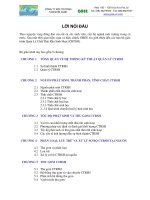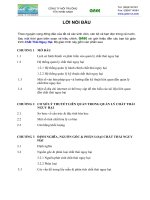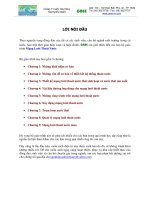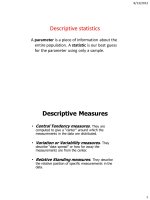Tài liệu tiếng anh - LAMNGHIEPVN.INFO (Hưng Bùi) Unit3
Bạn đang xem bản rút gọn của tài liệu. Xem và tải ngay bản đầy đủ của tài liệu tại đây (97.65 KB, 4 trang )
0
UNIT 3
VIETNAM AGRICULTURE
ACHIEVEMENTS AND DEVELOPMENT
ORIENTATION
(Extracted from ./en/stories/sectors.asp)
In groups, discuss Vietnam agriculture in recent years. What sector of
Vietnam agriculture do you think it has changed most? Then, compare with
the following text.
Read the following text
Taking off from an agricultural economy Vietnam agriculture has accounted for 30% of
export value and 25% of total national GDP. 76% of population is now living in rural areas.
In 1997/1998 period, agriculture, forestry and fishery sector created jobs over 66% of national
labor force. Nominal income of rural people has increased by 12% a year from 92/93 to 97/98
with the agricultural contribution of 81%. Agricultural and rural development is considered a
foundation for general economic development and the implementation of modernization and
industrialization.
Renovation in agriculture is the kick-start for Vietnam economic reform, creating solid
background for economic development. Prior to 1988, food security in Vietnam was not fully
assured, domestic demand could only be met by importing food from international markets.
But in 1990-1999, agriculture sector has experienced great progress with average growth rate
of 4.5% year, thanks to right policies on allocating land use right to farmers, developing
household economy, liberalizing trade, developing rural credit and providing extensions
services.
Over the last ten years, food output has increased averagely 1.2 million tons/year. Rice
export in 1999 was 4.5 million tons. Cultivation and livestock sectors have developed in the
direction of diversifying products and improving efficiency of land and labor. Specialized
zones for several main industrial crops have been established in great number. Output of
coffee, rubber, tea and sugar gained 400, 200, 65, thousand tons respectively. Fruit area is
about 450 thousand ha with estimated output of 4.5 million tons. Growth rate of livestock
sector is 5-6%/year. In 1999, total meat production attained 1.75 million tons, 7.7% higher
than 1998 figure.
While the production of livestock products, sugar, fruit and vegetable and etc is mainly
for satisfying domestic market demand, many others are for export at high rate such as coffee
(95%0, cashew (90%), rubber (80-85%), pepper (90%), tea (50%) and etc. form the country in
serious shortage of food, Vietnam becomes the second largest rice exporter, the second
Arabica coffee exporter, the forth cashew biggest exporter in the world. In 1999, agricultural
export volume was estimated at 3.25 billion USD, an increase of 11%.
Agricultural and rural economic structure has initially changed towards sector and crop
diversification, making contribution to transformation national economic structure in the
direction of increasing proportion of industry and services. There are now nearly 12 million
households in rural areas, including 10 million involving in agricultural production
(equivalent to 80.6%). In agricultural sector, the structure of cultivation and livestock changed
in the direction of decreasing cultivation proportion (77.6%) and raising livestock ratio
(22.5%) while absolute value of each sector has increased. Crop structure has been
1
diversified; food crops monoculture has been rejected to improve soil efficiency. Livestock
sector has been transformed towards increasing quantity and ratio of commercial cattle and
milk.
* Comprehension questions
1. Work in pairs, answer the following questions:
1. How many percentages has Vietnam agriculture accounted for export value and for
total national GDP?
2. What is agricultural and rural development considered?
3. What is the kick-start for Vietnam economic reform?
4. How could domestic demand in Vietnam prior to 1988 be met?
5. What was the average growth rate of agriculture sector?
6. What did agricultural sector in 1990-1999 experienced great progress thanks to ?
7. How many tons of rice was exported in 1999?
8. What is the growth rate of livestock sector per year?
9. Does Vietnam become the third largest rice exporter?
10. How has soil efficiency improved?
2. These statements are True (T) or False (F)
………1. In 1997-1998 period, agriculture sector created jobs for over 66% of national
labor force.
………2. Agricultural and rural development is considered a foundation for general
economic development.
………3. Investment and the growth of industry is basis for Vietnam economic reform.
……….4. Specialized zones for several main industry sector have been established in
great number over the last 10 years.
……….5. In 1999. total meat production attained higher than 1998 figure.
……….6. In 1999, there was a decrease in agricultural export volume.
* Vocabulary exercises
1. Fill in the blanks with the words from the text
1. The state of the domestic……………is very worrying.
2. ………….production has rapidly increased in recent years.
3. My college is closed for…………… because it is very old.
4. The average …………..of the factory is 20 cars a day.
5. …….for skilled workers is high; but there was no ………for unskilled ones
6. Tax is payable on all………………………over $ 2000.
7. The signing of such a treaty would be a major ………………..towards world peace.
8. Imperfect articles are ………………..by our quality control.
9. She used to be terribly shy, but a year abroad has completely……..her.
10. Vietnam has a ……… of
people
11. Lack of water will stunt the plant’s ………………..
12. The city suffers from a shortage of building…………….
2
13. ………….. is a cropping system in which fields of single crops are cultivated.
2. Give corresponding types of words for the given words
1. Renovation (n)…………..(v)?
2. Improve (v)………………(n)?
3. Transform (v)…………….(n)?
4. Efficiency (n)……………..(adj)?
5. Involve (v)………………...(n)?
* Grammar Review
The Present Perfect Tense
1. You are asking your friend about things she/he has done in his life. Use the words in
brackets to make your questions.
1. (you ever/be/ to South America?)
2. (you/read/ any/English books?)
3. (how many times/you/be/in love?)
4. (you ever/speak /to a famous person?)
5. (you/ever/ have/ a nightmare?)
2. Rewrite each of the following sentences in such a way that it means exactly the same as the
sentence provided
1. Laurence hasn’t seen his sister since she left for Japan
Laurence last…………………………………………………………………………….
2. I haven’t been here before
It’s the first time…………………………………………………………………………
3. It’s ages since my sister was last here
My sister hasn’t…………………………………………………………………………
4. I haven’t spoken to her for two weeks.
The last time…………………………………………………………………………….
5. They have worked in that company since 1987
They began………………………………………………………………………………
6. I started worked for the company a year ago
I have……………………………………………………………………………………
7. The last time it rained was a fortnight ago
It …………………………………………………………………………………………
8. How long has Jeanne been engaged?
When……………………………………………….……………………………………
9. It’s the first time he has failed an exam
He’s …………………………………………………………………………………….
9. She has just finished the job
She finished……………………………………………………………………………….
*Writing
3
Write a short essay about what you think/hope about Vietnam Agriculture.
*Translation
1. Translate the paragraphs 1,2, and 5 into Vietnamese
2. Translate into English:
1.Tăng trưởng trong lĩnh vực nông nghiệp có ý nghĩa quan trọng không những đối với
tăng trưởng chung của nền kinh tế mà còn đối với việc tạo công ăn việc làm và xoá đói, giảm
nghèo.
2. Đời sống đa số nông dân được cải thiện rỏ rệt, tốc độ tăng thu nhập đạt trên 10% thời
kỳ 1995 đến nay. Trừ một số vùng có thiên tai, vùng sâu, vùng cao, tình trạng thiếu lương
thực trên diện rộng đã được khắc phục.
1. Mục tiêu phát triển dài hạn về nông nghiệp là xây dựng một nền nông nghiệp hàng
hoá đa dạng, và mạnh, dựa trên cơ sở phát huy các lợi thế so sánh, áp dụng công nghệ mới, có
khả năng cạnh tranh trong nước và quốc tế.
2. Xây dựng nông thôn mới có cơ cấu kinh tế phù hợp, cơ cấu nông nghiệp-công
nghiệp-dịch vụ cùng phát triển, được công nghiệp hoá; hiện đại hoá gắn với đô thị hoá, mọi
người có việc làm, có cuộc sống sung túc, không còn đói nghèo, xã hội nông thôn dân chủ,
công bằng văn minh, giữ gìn bản sắc văn hoá dân tộc.









